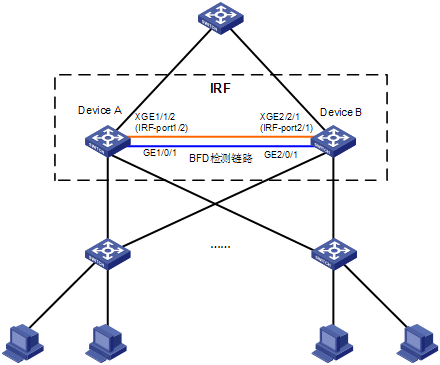问题描述:
做完堆叠用两对互联起动态聚合做bfd mad监测,查看聚合组选中状态只有一对是ADEF状态,另一对是A状态。为什么会这样?
组网及组网描述:
- 2021-08-02提问
- 举报
-
(0)

您好,参考
1.8 IRF显示和维护
在完成上述配置后,在任意视图下执行display命令可以显示配置后IRF的运行情况,通过查看显示信息验证配置的效果。
表1-18 IRF显示和维护
操作 | 命令 |
显示IRF中所有成员设备的相关信息 | display irf [ | { begin | exclude | include } regular-expression ] |
查看IRF的拓扑信息 | display irf topology [ | { begin | exclude | include } regular-expression ] |
显示所有成员设备上重启以后生效的IRF配置 | display irf configuration [ | { begin | exclude | include } regular-expression ] |
显示IRF链路的负载分担模式 | display irf-port load-sharing mode [ irf-port [ member-id/port-number ] ] [ | { begin | exclude | include } regular-expression ] |
显示IRF设备的主备倒换状态 | display switchover state [ slot member-id ] [ | { begin | exclude | include } regular-expression ] |
显示MAD配置信息 | display mad [ verbose ] [ | { begin | exclude | include } regular-expression ] |
1.9.2 IRF典型配置举例(BFD MAD检测方式)
![]()
本例仅适用于S5500-EI系列交换机。
1. 组网需求
由于网络规模迅速扩大,当前中心交换机(Device A)转发能力已经不能满足需求,现需要在保护现有投资的基础上将网络转发能力提高一倍,并要求网络易管理、易维护。
2. 组网图
图1-18 IRF典型配置组网图(BFD MAD检测方式)

3. 配置思路
l Device A处于局域网的汇聚层,为了将汇聚层的转发能力提高一倍,需要另外增加一台设备Device B。
l 鉴于第二代智能弹性架构IRF技术具有管理简便、网络扩展能力强、可靠性高等优点,所以本例使用IRF技术构建网络汇聚层(即在Device A和Device B上配置IRF功能),接入层设备通过聚合双链路上行。
l 为了防止万一IRF链路故障导致IRF分裂、网络中存在两个配置冲突的IRF,需要启用MAD检测功能。因为成员设备比较少,我们采用BFD MAD检测方式来监测IRF的状态。s
4. 配置步骤
![]()
为便于区分,下文配置中假设IRF形成前Device A的系统名称为DeviceA,Device B的系统名称为Device B。
(1) 配置设备编号
# Device A保留缺省编号为1,不需要进行配置。
# 在Device B上将设备的成员编号修改为2。
<DeviceB> system-view
[DeviceB] irf member 1 renumber 2
Warning: Renumbering the switch number may result in configuration change or loss. Continue? [Y/N]:y
[DeviceB]
(2) 将两台设备断电后,按图1-18所示连接IRF链路,然后将两台设备上电。
# 在Device A上创建设备的IRF端口2,与物理端口Ten-GigabitEthernet1/1/2绑定,并保存配置。
<DeviceA> system-view
[DeviceA] interface ten-gigabitethernet 1/1/2
[DeviceA-Ten-GigabitEthernet1/1/2] shutdown
[DeviceA] irf-port 1/2
[DeviceA-irf-port1/2] port group interface ten-gigabitethernet 1/1/2
[DeviceA-irf-port1/2] quit
[DeviceA] interface ten-gigabitethernet 1/1/2
[DeviceA-Ten-GigabitEthernet1/1/2] undo shutdown
[DeviceA-Ten-GigabitEthernet1/1/2] save
# 在Device B上创建设备的IRF端口1,与物理端口Ten-GigabitEthernet2/2/1绑定,并保存配置。
<DeviceB> system-view
[DeviceB] interface ten-gigabitethernet 2/2/1
[DeviceB-Ten-GigabitEthernet2/2/1] shutdown
[DeviceB] irf-port 2/1
[DeviceB-irf-port2/1] port group interface ten-gigabitethernet 2/2/1
[DeviceB-irf-port2/1] quit
[DeviceB] interface ten-gigabitethernet 2/1/1
[DeviceB-Ten-GigabitEthernet2/2/1] undo shutdown
[DeviceB-Ten-GigabitEthernet2/2/1] save
# 激活DeviceA的IRF端口配置。
[DeviceA-Ten-GigabitEthernet1/1/2] quit
[DeviceA] irf-port-configuration active
# 激活DeviceB的IRF端口配置。
[DeviceB-Ten-GigabitEthernet2/2/1] quit
[DeviceB] irf-port-configuration active
(3) 两台设备间将会进行Master竞选,竞选失败的一方将自动重启,重启完成后,IRF形成,系统名称统一为DeviceA。
(4) 配置BFD MAD检测
# 创建VLAN 3,并将Device A上的端口GigabitEthernet1/0/1和Device B上的端口GigabitEthernet2/0/1加入VLAN中。
<DeviceA> system-view
[DeviceA] vlan 3
[DeviceA-vlan3] port gigabitethernet 1/0/1 gigabitethernet 2/0/1
[DeviceA-vlan3] quit
# 创建VLAN接口3,并配置MAD IP地址。
[DeviceA] interface vlan-interface 3
[DeviceA-Vlan-interface3] mad bfd enable
[DeviceA-Vlan-interface3] mad ip address 192.168.2.1 24 member 1
[DeviceA-Vlan-interface3] mad ip address 192.168.2.2 24 member 2
[DeviceA-Vlan-interface3] quit
# 按图1-18所示连接BFD MAD链路。
- 2021-08-02回答
- 评论(0)
- 举报
-
(0)
暂无评论
编辑答案


亲~登录后才可以操作哦!
确定你的邮箱还未认证,请认证邮箱或绑定手机后进行当前操作
举报
×
侵犯我的权益
×
侵犯了我企业的权益
×
- 1. 您举报的内容是什么?(请在邮件中列出您举报的内容和链接地址)
- 2. 您是谁?(身份证明材料,可以是身份证或护照等证件)
- 3. 是哪家企业?(营业执照,单位登记证明等证件)
- 4. 您与该企业的关系是?(您是企业法人或被授权人,需提供企业委托授权书)
抄袭了我的内容
×
原文链接或出处
诽谤我
×
- 1. 您举报的内容以及侵犯了您什么权益?(请在邮件中列出您举报的内容、链接地址,并给出简短的说明)
- 2. 您是谁?(身份证明材料,可以是身份证或护照等证件)
对根叔社区有害的内容
×
不规范转载
×
举报说明




暂无评论